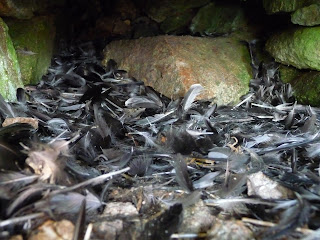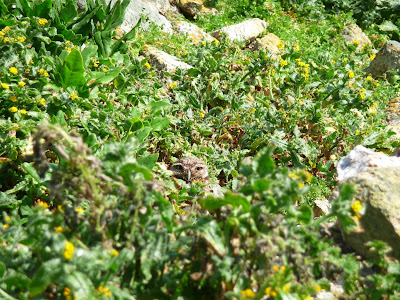Every five days on Southeast Farallon, an overworked and windblown (but well fed) intern has to undertake the burden of what is euphemistically named the “Ashy Wing Walk.” This falsely conjures up images of a casual stroll while marveling at the flutter of wings as storm petrels dance like fairies around your head. If only. This walk is a survey for predated storm petrels – eaten by overwintering Burrowing Owls or nesting Western Gulls who take their territories very seriously. Usually all that is left are the bird’s wings. This task may seem a bit morbid, but it’s crucial to our studies of the Ashy Storm Petrel. This is a bird the size of a swallow that’s more like a miniature albatross. They are endemic to the California Current, can live well over 35 years and sometimes take until December to finish fledging their chicks. This species of Special Concern in California has shown dramatic population decreases over the past several decades, especially here at the Farallones – their largest colony in the world.
I call it the “Walk of Death.” I think of myself as the metaphorical cop walking her beat. It’s the same route every five days. I pace and rhythmically tap my mechanical pencil against my thigh and look for anything suspicious. My beat takes me across the Rubble Pile where Pigeon Guillemots breed, along the Helicopter Pad, up Lighthouse Hill and finally concludes at the old Egger’s House, the remains of the storage cache for murre eggs on their way to San Francisco during the Gold Rush. For the most part, it remains uneventful except for finding one or two slimy regurgitated wings, courtesy of a peckish gull. Good for the petrels, yawns for the intern.
Inadvertently, a chill run downs my spine, it’s the Farallon version of an episode of CSI . After the collective gasps of horror, comes the gruesome task of reaching in among the carnage and hand picking out the individual wings. This allows us obtain an accurate estimate of the number of storm petrels killed. The largest collection we’ve found this year is twenty wings in one roost.
The next question you ask, who is the culprit? A Peregrine Falcon? A Raven? An extra hungry gull that isn’t satiated by a diet of anything and everything? No, my fellow sleuths, the perpetrator lies hidden within this photo:
While they rate very high on the cuteness quotient, overwintering Burrowing Owls are major predators of storm petrels during the spring, after abundant house mice have their seasonal population crash. Western Gulls also take many storm petrels throughout a breeding season. Predation is a part of life for all the Farallon seabirds, and studies like the wing walk are key to our understanding of these important populations. Death is just a part of everyday experience out here.














